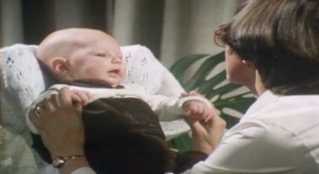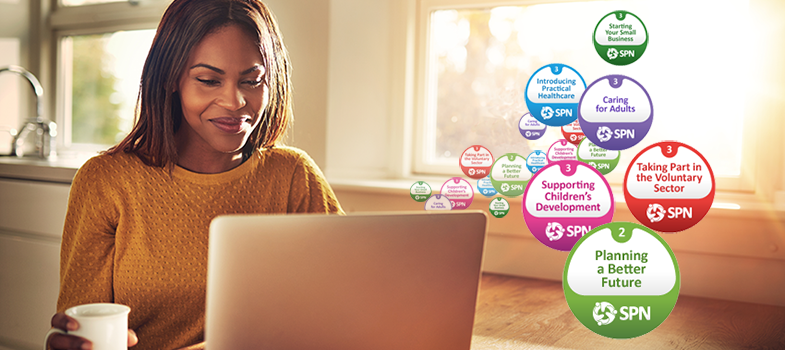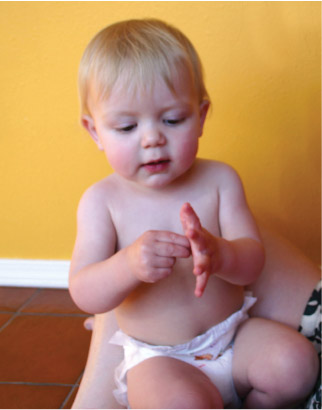1 Babies and the early years
To understand literacy skills, we would like you to start by thinking about how babies learn to communicate.
It is well known that babies want to communicate with other people and they move quickly from communicating through crying and making noises to saying recognisable words. The following extract taken from the Words for Life [Tip: hold Ctrl and click a link to open it in a new tab. (Hide tip)] website shows how quickly babies move on from those initial communications to saying their first word, then on to speaking their first sentence.
Baby and toddler communication milestones
‘Look at me copying you.’
From birth I will make eye contact and copy your expressions. This is one of the first ways in which I learn to communicate.
‘My first smile.’
Around six weeks I may smile for the first time.
‘My first laugh.’
Between three and six months I will probably start laughing. Hearing my infectious laughter will help us bond even more and make it more rewarding to talk and interact with me.
‘Mummy look at me!’
At around six months I will start using noises to get your attention; coos or gurgles.
‘Ma ma ma, Da da da’
Around eight months I will probably start to babble. The repetitive noises I make are the beginnings of speech and give me the chance to exercise my mouth.
‘Did you say my name?’
Around eight or nine months I will begin to recognise and respond to my name.
‘My first word!’
Around 12 months I may say my first word. And by 13 months I may be using up to six words.
‘I’ve reached 50 words!’
Around 18 months I will have increased my vocabulary to about 50 words. This is a time in my life where you may notice an explosion in my vocabulary; it’s an exciting time for me as I quickly add more and more words.
‘My first sentence!’
At some point between the ages of 18 and 24 months I will put together my first sentence. It may not be grammatically correct or easy to understand but it’s a very important part of my language development. Remember to keep reading, talking and interacting with your child as this will help them continue to expand their vocabulary and their understanding of grammar, words and language.
Activity 1

Transcript
Babies’ communication
James
James Description:
Baby James is lying in a chair looking at his Mother who has eye contact with him and is talking to him and smiling. She sometimes holds his hands and James moves his head towards her and gurgles.
James smiles at his Mother and moves his body as though he is trying to reach out to her. James has lolled to one side, still maintaining eye contact with his Mother who gently moves him upright.
As his Mother talks gently to him, James smiles in response. James is aware of the happiness in his Mother’s voice by gurgling and smiling.
Alice
Alice Description:
Alice is lying on her back on a baby changing mat and is looking at her Mother who is leaning over her. Alice responds to her Mother’s voice by moving her arms and gurgling. Alice also moves her body.
Alice waves her arms in the air and is quite active. Alice is looking at her Mother at all times. When her Mother asks Alice should she answer the door as the bell has rung, Alice squeals as though in response to the question.
Alice squeals again as her Mother continues to pose questions and moves her arms and body.
Sebastian
Sebastian Description:
Sebastian’s Mother is holding him so that his face is directly opposite hers. She rubs her head against his face and upper body. The Mother makes happy cooing noises and Sebastian mimics her in response.
David
David Description:
David is sitting upright on a play mat with his Mother holding on to him so he doesn’t fall. He is actively looking at his surroundings. His Mother watches him all the time and speaks to him gently. David continues to look around and babbles back.
Rebecca
Rebecca Description:
Rebecca is sitting on her Mother’s knee and is using both hands to drink from a feeding cup. Her Mother talks to her, all the time praising Rebecca for drinking unaided. Rebecca looks around all the time.
We would like you to watch this short video clip of babies communicating with their parents. While you are watching, make a note of the facial expressions of the babies.
- What kind of emotions do you think they are expressing?
You could use the response box for your notes – only you will see them.
Comment
Was it easy for you to identify the different facial or body expressions and attach an emotion to them? Certainly, happiness is quite easy to spot, but what about something like ‘anticipation’? Did you think that some babies showed more of one emotion than others?
Did you notice how attentive James was, keeping his eyes on his mother’s face? Alice was very vocal and communicative. Rebecca seemed to be anticipating the toy popping out and got quite excited while waiting. Sebastian made eye contact and mouth movements to his mother, and David babbled away and initiated frequent conversations.
It was easy to see how the older babies initiated communication. David, for example, was quite vocal and Rebecca was very demonstrative, waving her arms and bouncing up and down. Sometimes it may not be clear that a baby is actually starting communication rather than responding to something an adult has started off with them.
But did you notice, towards the beginning of the clip, how James, who was only 10 weeks old, raised both hands and made mouthing movements and again raised his hand at the end? Although these kinds of movements could be thought of as largely uncontrolled, researchers have found them common and predictable enough to conclude that even babies of this age initiate communication.
Interaction with adults is an important stage in the development of a baby’s communication skills. The babies in the video clip were having conversations with their mothers – for example, what Alice’s mother was saying when showing her the doll. This kind of talking – where there is exaggerated use of words and syllables and much repetition – is called ‘parentese’ by child psychologists. It is important because it introduces babies to patterns in their language and establishes familiar routines for them.
In their long-term study analysing the verbal interactions between parents and their children, Hart and Risley (1999, cited in Roberts, 2009) identified five specific ways that parents talked to children that consistently had the most positive impact on the children’s development, and their long-term verbal ability:
- they just talked, generally using a wide vocabulary as part of daily life
- they tried to be nice, expressing praise and acceptance and few negative commands
- they told children about things, using language with a high information content
- they gave children choices, asking them their opinion rather than simply telling them what to do
- they listened, responding to them rather than ignoring what they said or making demands.
It seems clear from these five bullet points that if you talk to children in an encouraging, informative and positive manner, you are helping them to develop the all-important skills of speaking and listening. It is these skills that help children to develop language and learn to read.
You have seen how adults can play a key role in a child’s development from a very young age and there is no reason why the five specific ways of talking to children (identified above) should not form the basis of good practice at all levels of education.
Learning outcomes

